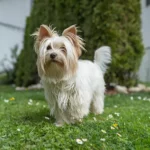Meet the Siberian Husky: a friendly and energetic dog. These beautiful dogs were first used in cold Siberia to pull sleds. Now, they are loved for being fun and loyal friends.
Cool Things About Siberian Huskies
- Super Friendly: Huskies love people and make great family pets. They are really good at making friends.
- Smart and Playful: They are clever and learn quickly, which makes training them fun and interesting.
- Full of Energy: Huskies are active and love to run and play. They are great for people who like outdoor adventures.
Life with a Siberian Husky
Having a Husky is exciting! They do best with regular play and learning new things. They like having tasks to do and enjoy being active. Huskies are great for families who can spend lots of time with them and keep them busy.
This table provides a detailed profile of the Siberian Husky breed, designed to help potential owners understand their specific needs and characteristics.
| Category | Detail |
|---|---|
| Breed Name | Siberian Husky |
| Origin | Siberia, Russia |
| Breed Group | Working (AKC), Northern (UKC) |
| Size Classification | Medium to Large |
| Weight Range | Males: 45-60 lbs (20-27 kg), Females: 35-50 lbs (16-23 kg) |
| Height Range | Males: 21-23.5 inches (53-60 cm), Females: 20-22 inches (51-56 cm) |
| Life Expectancy | 12-14 years |
| Coat Type | Double coat with a dense undercoat and a longer topcoat |
| Coat Colors and Markings | Variety of colors from black to pure white, including grays, reds, and sables; often with distinctive facial markings |
| Grooming Needs | High; requires regular brushing, especially during shedding seasons |
| Shedding | Heavy, particularly during spring and fall |
| Temperament | Friendly, outgoing, mischievous |
| Behavioral Tendencies | High prey drive, tendency to roam and escape, enjoys howling |
| Social/Behavioral Traits | Sociable with people and other dogs, not typically aggressive |
| Activity Level | High; requires vigorous daily exercise |
| Trainability | Moderate; intelligent but can be independent and stubborn |
| Intelligence Level | Intelligent, but training can be challenging due to their independent nature |
| Barking Tendency | Low; more likely to howl |
| Health Issues | Hip dysplasia, eye disorders (like cataracts and corneal dystrophy), skin conditions |
| Dietary Needs | High-quality diet with adequate protein and fat, particularly for active dogs |
| Suitability for | Active individuals, families with a secure yard, experienced dog owners |
| Breed History | Originally bred by the Chukchi people in Siberia for pulling sleds over long distances |
| Exercise Requirements | At least 1-2 hours of intense exercise daily, including running and play |
| Space Requirements | Best with a large, securely fenced yard; not well-suited for apartment living |
| Sleeping Requirements | Typically 12-14 hours a day, including naps |
| Climate Adaptability | Excellent in cold climates; can struggle in hot weather |
| Travel and Relocation Considerations | Adaptable but need to maintain exercise routine; can be escape artists |
| Compatibility Scorecard | City Living: 2/5, Families: 4/5, Novice Owners: 2/5, Exercise Enthusiasts: 5/5 |
| Ancestry and Bloodlines | Descended from ancient Siberian sled dogs |
| Notable Traits | Striking appearance, endurance, thick double coat, blue or multicolored eyes |
| Role | Sled dogs, companions, show dogs |
| Care Requirements | Regular exercise, mental stimulation, secure living environment, consistent training |
| Cost Breakdown | Food: $40-$70/month, Grooming: $50-$100 during shedding seasons, Veterinary care: $200-$600/year, Training: $50-$200/course, Insurance: $30-$60/month |
| Training and Socialization | Early socialization and obedience training are crucial; can be challenging due to their independent nature |
| Time Commitment | Several hours per day for exercise, grooming, and companionship |
| Enrichment Activities | Sledding, hiking, agility training, interactive play |
| Common Training Mistakes | Lack of consistency, not providing enough mental and physical stimulation |
| Seasonal Care | Extra brushing during shedding seasons, protection from heat in summer |
| Allergy Considerations | Not hypoallergenic; heavy shedding |
| Health Screening | Hip evaluation, ophthalmologist evaluation, regular check-ups for skin conditions |
| Insurance Recommendations | Coverage for breed-specific conditions and potential health issues |
| Mental Stimulation Needs | High; requires activities that engage their intelligence and energy |
| Kennel Club Recognitions | AKC, UKC, FCI |
| Breed Standards | Medium-sized, well-balanced, and muscular; erect triangular ears, sickle tail |
| Litter Size | 4-8 puppies |
| Level of Protection | Moderate; alert but not typically used as guard dogs |
| Participation in Dog Sports | Successful in sled racing, agility, and obedience competitions |
| Noise Level | Known for howling rather than barking; vocalizes frequently |
| Odor Level | Low; regular grooming helps maintain cleanliness |
| Watchdog/Alarm | Moderate; alert to changes in their environment but not aggressive |
| Therapeutic Use | Sometimes used as therapy dogs due to their friendly nature |
| Cultural Significance | Famous for their role in sled racing, including the 1925 serum run to Nome |
| Rescue Organizations | Siberian Husky Rescue/Referral of California, Tails of the Tundra Siberian Husky Rescue |
| Certification and Testing | Recommended to have genetic testing for eye conditions and hip dysplasia |
| FAQ Section | Q: Can Siberian Huskies live in hot climates? A: They can adapt but require measures to stay cool. Q: Are Siberian Huskies good with children? A: Yes, generally good with children but should be supervised due to their size and energy. Q: How much exercise does a Siberian Husky need? A: They require extensive daily exercise to maintain their health and happiness. |

